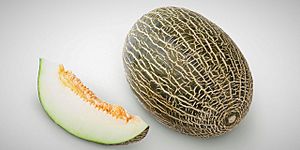Santa Claus melon facts for kids
Quick facts for kids Cucumis melon 'Sancho' |
|
|---|---|
 |
|
| Species | Cucumis melo |
| Cultivar group | Inodorus Group |
| Cultivar | 'Sancho' |
| Origin | Spain |
The Santa Claus melon is a special type of melon. It is also called the Christmas melon or Piel de Sapo. This Spanish name means "Toad Skin" because of its green, blotchy skin. This melon belongs to the same plant family as pumpkins and cucumbers, called Cucurbitaceae. It grows to about 30 centimeters (12 inches) long and has an oval shape.
The Santa Claus melon has a thick, green skin with stripes. Inside, its flesh is pale green to white. It tastes mild and sweet, much like a honeydew melon.
Contents
What Does a Santa Claus Melon Look Like?
The Santa Claus melon gets its Spanish name, Piel de Sapo, from its unique skin. This skin is green and often has blotches, making it look a bit like a toad's skin. There is a similar melon called 'Amarillo' or canary melon. It has the same shape but a bright yellow skin.
The Santa Claus melon's green and yellow stripes can make it look a little like a small watermelon. Its inside is pale green and tastes gentle and sweet. To know if a Santa Claus melon is ripe, gently press its ends. If they feel a bit soft and the melon has a bright yellow color, it's ready to eat!
This melon got its English name because it can be stored for a long time. It can last "until Christmas," which is why it's called the Santa Claus or Christmas melon.
Where Do Santa Claus Melons Grow?
You can find Santa Claus melons in many places around the world. In the Northern Hemisphere, they are grown in places like California and Arizona. Farmers there pick them from June through October. When it's winter in these areas, the melons come from warmer places. They are imported from South America, like Brazil and Central America. This helps make sure Europe has melons during autumn, winter, and spring.
It takes about 110 days for a Santa Claus melon to grow fully after planting. They can reach about 30 centimeters (12 inches) in length. They are about half that in width.
Growing Santa Claus Melons in Spain
The Piel de Sapo melon first came from Spain. It is still grown there a lot. About 30,000 hectares (74,000 acres) of these melons are grown each year. La Mancha is a main area in Spain for growing them, with 12,000 hectares.
Another important growing area is Murcia. This region specializes in growing early crops of the melon. Farmers there usually plant in mid-March. They then harvest the melons from mid-June to mid-July.
One very popular type of Piel de Sapo melon in Spain is called 'Sancho'. This is a special hybrid type created by the seed company Syngenta. In the past, many different types of melons were grown from seeds that were not mixed. But now, hybrid types like 'Sancho' are more common. They give farmers more melons and are better at fighting diseases. Older types of melons are kept safe in special collections.
Farmers in Spain plant these melons outdoors from May to June. They start picking them in mid-July, and the harvest ends in September.
How to Use and Store Santa Claus Melons
For the best taste, keep an uncut Santa Claus melon at room temperature for a day or two before you eat it. This makes the flesh juicier and softer. Once you cut the melon or if it is already ripe, you should put it in the refrigerator. It's best to keep it in plastic.
This melon is known for lasting a long time. It can stay fresh for up to six weeks longer than many other types of melons!

